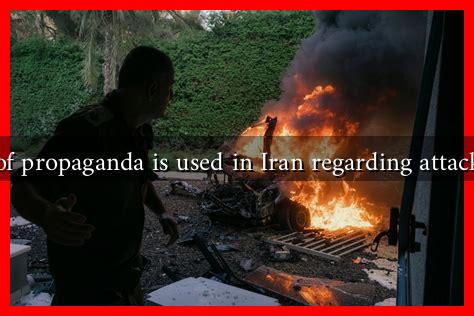-
Table of Contents
- What Kind of Propaganda is Used in Iran Regarding Attacks on Israel?
- The Nature of Iranian Propaganda
- Media Control and State Narratives
- Key Themes in Iranian Propaganda
- Case Studies: Recent Conflicts and Propaganda
- The Impact of Propaganda on Public Perception
- Conclusion: The Power of Propaganda in Shaping Narratives
What Kind of Propaganda is Used in Iran Regarding Attacks on Israel?
In the complex geopolitical landscape of the Middle East, Iran’s relationship with Israel is fraught with tension and hostility. The Iranian government employs a variety of propaganda techniques to shape public perception and justify its stance against Israel. This article explores the types of propaganda used in Iran regarding attacks on Israel, examining the methods, messages, and implications of this information warfare.
The Nature of Iranian Propaganda
Iranian propaganda is multifaceted, utilizing state-controlled media, social media platforms, and public speeches by officials to disseminate its narratives. The primary goals of this propaganda include:
- Justifying military actions against Israel
- Mobilizing public support for the government
- Promoting anti-Zionist sentiment
- Strengthening regional alliances with groups opposed to Israel
Media Control and State Narratives
The Iranian government exerts significant control over its media landscape. State-run outlets like Press TV and IRNA (Islamic Republic News Agency) play a crucial role in shaping narratives about Israel.
. These outlets often frame Israel as an aggressor and a threat to regional stability. For instance, during conflicts such as the Gaza wars, Iranian media frequently highlight civilian casualties and portray Israel as committing war crimes.
In addition to traditional media, the Iranian government has embraced social media as a tool for propaganda. Platforms like Telegram and Instagram are used to disseminate messages quickly and widely, often bypassing traditional censorship. This digital strategy allows the Iranian regime to reach younger audiences and engage them in anti-Israel discourse.
Key Themes in Iranian Propaganda
Several recurring themes characterize Iranian propaganda regarding Israel:
- Victimhood Narrative: Iran often portrays itself and its allies as victims of Israeli aggression. This narrative is designed to elicit sympathy and support from both domestic and international audiences.
- Resistance and Martyrdom: The concept of “resistance” against Israel is glorified, with martyrs celebrated as heroes. This theme is particularly prevalent in the context of groups like Hezbollah and Hamas, which Iran supports.
- Conspiracy Theories: Iranian propaganda frequently includes conspiracy theories that depict Israel as a puppet of Western powers, particularly the United States. This narrative aims to delegitimize Israel’s actions and rally support against perceived imperialism.
Case Studies: Recent Conflicts and Propaganda
Recent conflicts have provided fertile ground for Iranian propaganda. For example, during the 2021 Gaza conflict, Iranian leaders and media outlets condemned Israel’s actions, framing them as genocidal. Supreme Leader Ayatollah Ali Khamenei referred to Israel as a “cancerous tumor” that must be eradicated, a statement that resonated with hardline factions within Iran and its allies.
Moreover, Iran’s support for Palestinian groups is often highlighted in propaganda campaigns. The Iranian government uses these narratives to position itself as a champion of the Palestinian cause, thereby enhancing its legitimacy both domestically and regionally.
The Impact of Propaganda on Public Perception
The effectiveness of Iranian propaganda is evident in public sentiment. Surveys indicate that a significant portion of the Iranian population supports the government’s anti-Israel stance, viewing it as a matter of national pride and Islamic duty. This support is crucial for the regime, especially in times of economic hardship and political dissent.
Furthermore, the propaganda serves to unify various factions within Iran, from hardliners to reformists, around a common enemy. This unity is essential for the regime’s stability, particularly in the face of internal challenges.
Conclusion: The Power of Propaganda in Shaping Narratives
Iran’s use of propaganda regarding attacks on Israel is a strategic tool that serves multiple purposes: justifying military actions, mobilizing public support, and promoting anti-Zionist sentiment. Through state-controlled media, social media, and powerful narratives, the Iranian government effectively shapes public perception and reinforces its ideological stance.
As the geopolitical landscape continues to evolve, understanding the nature and impact of Iranian propaganda is crucial for comprehending the broader dynamics of Middle Eastern politics. The narratives constructed by the Iranian regime not only influence domestic opinion but also have implications for regional stability and international relations.
For further reading on the topic, you can explore resources from Brookings Institution and C-SPAN.





